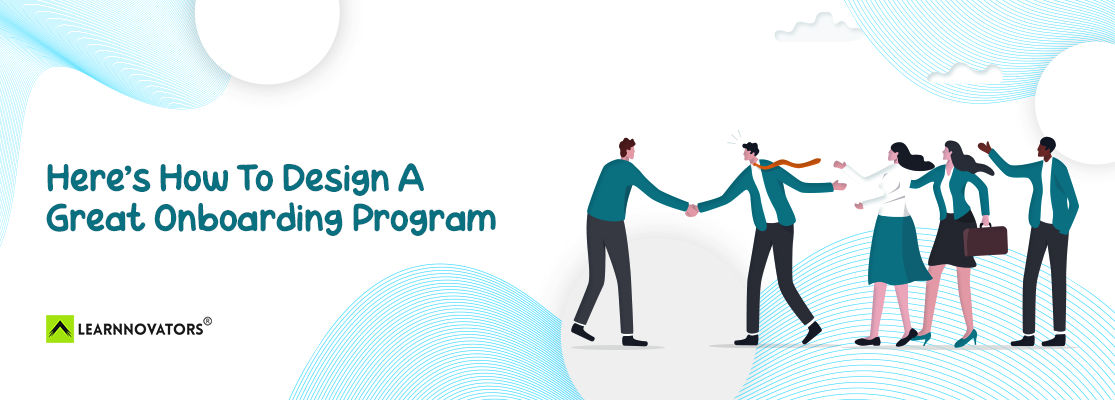Having written about creating a ‘values’ training program that rocks, I thought I should widen the net, and write about crafting an onboarding program as well.
As you’d expect, this post is not about why you need to create a good onboarding program. We all know what they say about first impressions, and about employees who leave an organization within their initial 90 days. No, this post is more about the what and the how of creating a fantastic onboarding experience. So, read on…
A good onboarding program will cover three areas:
- Organization-related: Covering the culture of the organization, how things work, vision, processes, etc.
- Job-related: Expectations from their role, goals, systems, reporting structure, etc.
- People-related: Team dynamics, interpersonal relations, etc.
Put another way, a good onboarding program is one that:
- Makes employees feel welcome and comfortable
- Inspires them on the company’s values and culture
- Helps them understand the vision and purpose of the organization
- Answers the question: ‘What’s in it for me?’ (or in other words, explains how the organization will help them grow and achieve their professional goals)
- Helps them understand the nitty-gritty of the policies, processes and procedures followed
- Gets them on their feet, running
Let’s now look at how to get there.
A great onboarding starts way ahead of Day 1, i.e., the day the employee becomes ‘attached’ to the organization formally. In fact, it starts even before you give them an offer, with:
- The communication that you share with the outside world, in the form of your website, branding, advertising, etc.
- The job description that you put out when you call for applications
- The interview process itself
These help form the initial impression in the person’s mind as to your organization’s brand and what it stands for. But how to handle these effectively is a separate post, perhaps even a series of separate posts, that I’ll reserve for another time.
Not considering the hiring process and the brand sentiment that’s given out before hiring, there are still plenty of opportunities to create an amazing impression, from the moment the offer is given, to the time the employee actually joins the organization. We call this pre-boarding.
Years ago, a friend of mine had joined a multinational company, and they had this bot-driven pre-boarding process, wherein they were periodically sent videos about the company, what it stands for, etc. The idea sounded really cool for a full five minutes, before the novelty started to fade away. Basically, they were doing the same boring onboarding training, repackaging it as pre-boarding, and delivering it through a shiny bot.
Please, let’s just avoid this.
The interval between a person accepting an offer with an organization and their actual day of joining the organization tends to be a very busy period for most people. At this time, they are either wrapping up their responsibilities with the previous company, or they are taking a well-earned break. This is the worst time to do checkbox activities like getting them to watch values videos, or have them fill up forms or the like.
On the contrary, it is the perfect occasion to get them excited about the company they’ve decided to join. Pre-recorded fun videos of existing employees (preferably team members of the potential employee) and top management introducing and talking about themselves, providing a sneak peak into the culture of the organization through some stories, a pop quiz containing organizational trivia are all great ideas to do just that.
Much like buyer’s remorse, employees too can have second thoughts about the offer they have decided to take up (all the more true in cases where they have juggled multiple offers before settling on yours). The above activities will give you a great opportunity to put all their doubts to rest.
Note that there are two keywords to keep in mind here:
- Fun: We want the employees to have fun and at the same time, be engaged with the organization. At this stage, it’s okay if it is the easy kind of fun.
- Simple: No one in your HR team is going to have the time to create tailored activities for each set of individuals, and that too, before they join the organization. Even if the activities are already defined, they are not going to be able to engage in synchronous sessions.
How much, and how often: While it might be tempting to send them TONS of material to go through, a good approach is to keep it to once or twice a week. So, if the lead time from the date of offer to the date of joining is about a month, then you would have four to eight pieces of information to share with the employee. If the lead time happens to be longer, then bring down the frequency of engagement and adjust accordingly.
Two to three days before the date of joining, it’s good to send them an onboarding schedule, so they know what exactly to expect on Day 1.
Day of Joining and Beyond
So, D-Day is finally here. Or should I say J-Day, for Joining Day? Assuming that you did your pre-boarding activities perfectly, the candidate has now turned into an employee, and is excited to get started.
Send a welcome e-mail: You would inevitably start with a welcome e-mail, introducing this new person to the entire team. This is the perfect time to get the new employee to create a short video introducing themselves, including a few fun facts that would be good to know for their co-workers. If video is not your organization’s thing, not to worry. You can get them to write about themselves, which you could then include in the welcome e-mail.
You can also post this video / note somewhere on the central Intranet, for other employees to view later. (This would also be included in pre-boarding new employees at a later date.)
Engage right from the beginning: There is no use drumming up excitement about and building up to Day 1, if you’re going to let the employee sit around waiting for things to get ready. Basically, before Day 1 comes around, you need to have the following prepared and handy:
- Paperwork for them to complete
- Hardware and software access, if applicable
- Access to all internal applications (HR, payroll, intranet, e-mail, LMS, other communication channels, etc.)
- Location access (if they’re going to be operating from a physical office space)
At the same time, you don’t want them to spend the entire day filling out paperwork or sitting through some boring training. After all, it is their first day in the organization, and you will need to make sure that their day is planned out with a mix of practical and fun activities.
Arrange a meeting with key people: What’s Day 1 without a meeting with the team? While the new employee may have read or watched their manager’s and teammates’ intros, this is a chance to meet and connect with them in real time, be it face-to-face or online.
While you do need to cover the important stuff in this meeting, also remember to inject a bit of levity. Other things you can do to make the new employee comfortable include:
- Lunch with the manager and / or the team
- Quick activities to help the team get to know each other better
- And if possible, a meeting or a lunch with someone from the top management
Consider onboarding (or any learning, for that matter) to be a process, not an event: You probably already know this, but let me say it again – onboarding is not a one and done activity; rather, it’s a process that continues through at least the first few months of the employee’s time with the organization.
That is not to say that it does not comprise of individual training events – it does.
Make sure that all essential training and information delivery is covered in a structured but well spaced out manner. This could include:
- Introduction to the organization, what it does, the various divisions, how it’s structured, etc.
- Statutory and compliance training (anti-harassment, diversity, fire safety and emergency preparedness, etc.)
- Common company knowledge (where things are, how stuff works around here, how to find what you need, etc.)
- Performance related, as applicable (what is expected from the role, what are the success indicators, etc.)
One common mistake that we see here is the thinking that the entire onboarding program has to be uniformly created, with a certain consistency in approach and presentation. Some even go so far as to say that the whole program has to be made into a single tight unit comprising several individual units. And they try to standardize things like templates, colors, fonts, etc.
But actually, this approach is wrong. It makes the entire program unwieldy and untenable to maintain. It can also quickly cross over into boring territory for the employee.
Instead, think of the entire program as a jigsaw puzzle, where the puzzle pieces can be pulled together to make a whole. Some puzzle pieces already exist elsewhere in the organization, while others need to be created afresh.
Also, look at and decide on the modality of each piece independently. Some could be online modules, while others need to be done as synchronous sessions. Yet others can probably remain as nicely designed PDFs. You get the idea.
Not all of these pieces need to be delivered immediately after joining. While some of them are important from a compliance perspective, and others are critical for the employee to get up and running, there are pieces that you could schedule for them to go through even a few weeks after joining. This can also give a breather to the employee, and avoid the fire hose effect.
Another good practice is to make all of the relevant content available for later reference as well.
Put in place a buddy system or a mentor system or both: A buddy can help the new employee acclimatize better to the environment. A mentor can provide the right support and tools, and catapult them to success.
Consider if either of these systems will suit your organization and its culture, and implement accordingly.
Perform frequent check-ins: A good practice is to schedule a check-in after a week of their joining, a month, a quarter, six months, and one year. This way you will have an idea of what the employee feels about the culture and their work. It will also give you a heads-up and some time to course correct in case something is not right.
These check-ins are ideally done by HR, or someone from the senior management team, without the presence of their immediate manager.
———-
So, these are my ideas for devising and implementing a great onboarding program.
What would you add?
Written by Srividya Kumar, Co-Founder @ Learnnovators






